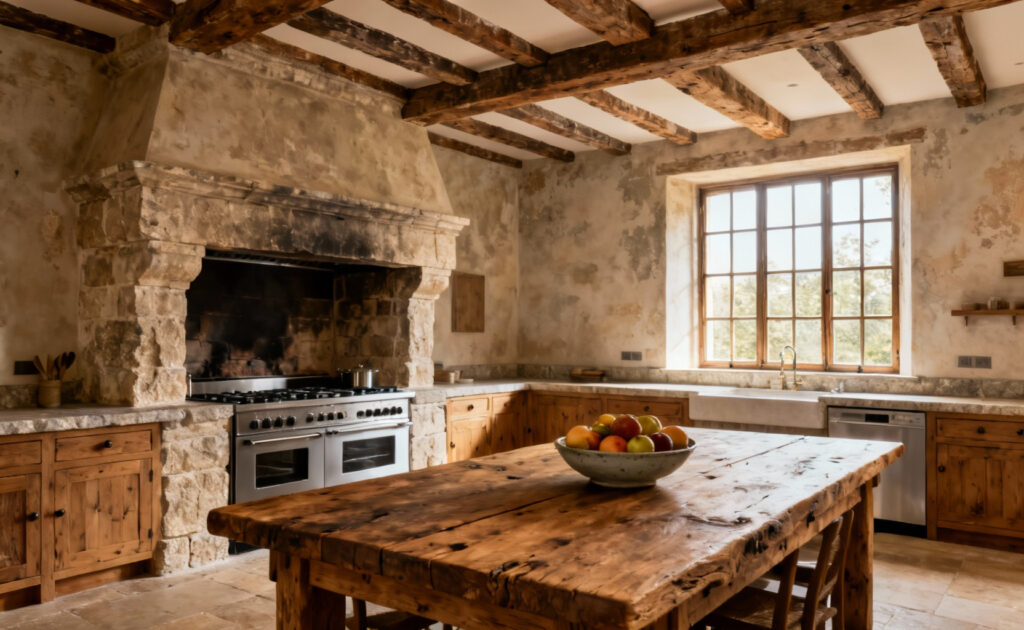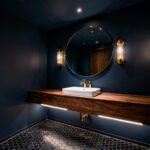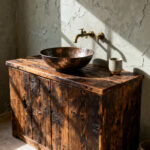Since the first hearth was built, the kitchen has been more than a room for preparing food; it has been the very soul of a home. It has evolved from a simple fire for sustenance to a sophisticated space that reflects a dwelling’s history and the lives lived within it. Today’s most intentional kitchens understand this profound duality—they must perform for modern life while honoring the architectural narrative they inhabit. The 20 principles that separate a kitchen of enduring character from a collection of fleeting trends haven’t changed in spirit for centuries.
This isn’t about creating a museum. It’s about engaging in a thoughtful dialogue with your home’s past. As a specialist in historic renovation, I’ve learned that the most successful projects don’t shout their modernity, nor do they mimic a bygone era. They whisper. They integrate new life so seamlessly that it feels as if it was always meant to be. This guide will walk you through the foundational philosophies, the honest materials, the ergonomic considerations, and the modern integrations that allow you to become a true steward of your home’s legacy.
Part I: Foundational Philosophies for the Enduring Kitchen
Before a single cabinet is chosen, we must begin with a philosophy of respect for what already exists. A truly timeless kitchen is born from a deep understanding of its context, an intellectual rigor that prevents common missteps and anchors every decision in authenticity.
1. Cultivating a Symbiotic Relationship with Architectural Provenance
The most important voice in your renovation is that of the house itself. Before planning, one must become a student of the home’s architectural narrative. This is more than knowing its age; it’s about understanding its stylistic lineage, original materials, and how it has evolved. This deep reading of the home’s character becomes the bedrock of all subsequent design choices, creating an unbreakable link between past and present.
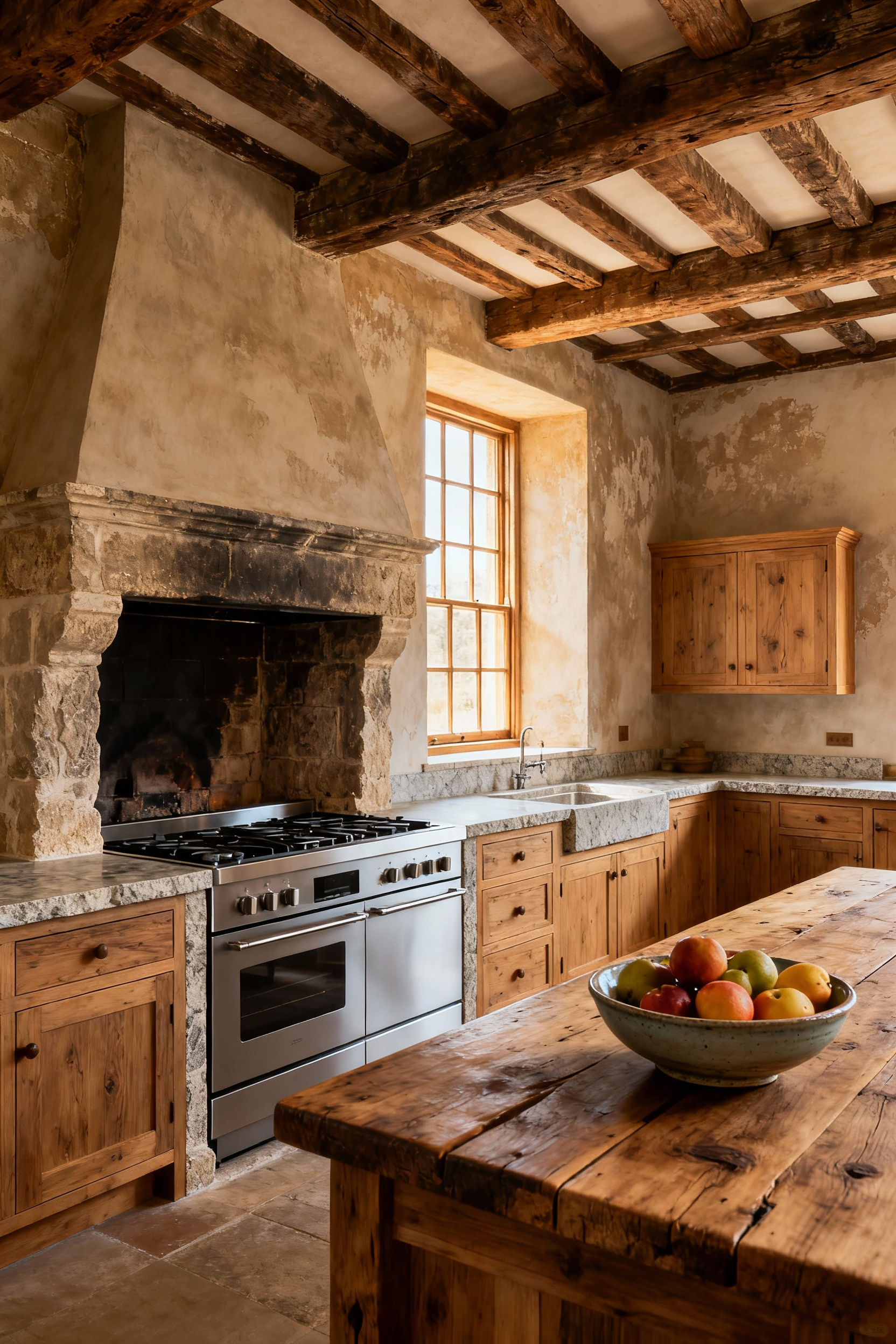
In my historic home renovation practice, I always tell clients that we should be guided by the home’s original grammar. A stately Georgian home demands a different vocabulary—perhaps painted inset cabinetry and soapstone—than a light-filled Arts and Crafts bungalow that calls for the warmth of quarter-sawn oak and the artistry of ceramic tile. The goal is to make the kitchen feel not new, but rediscovered, as if your thoughtful interventions have simply revealed its true, intended form.
2. Deconstructing the Anachronistic Fallacy
With a respect for provenance comes the need to avoid the anachronistic fallacy—the common trap of creating a pastiche of historical elements that results in a theatrical, rather than authentic, space. You are not creating a period film set. True mastery lies in interpreting the spirit of an era and thoughtfully adapting its logic for contemporary life. It’s about asking why things were done a certain way, and then finding modern equivalents that honor that intent.
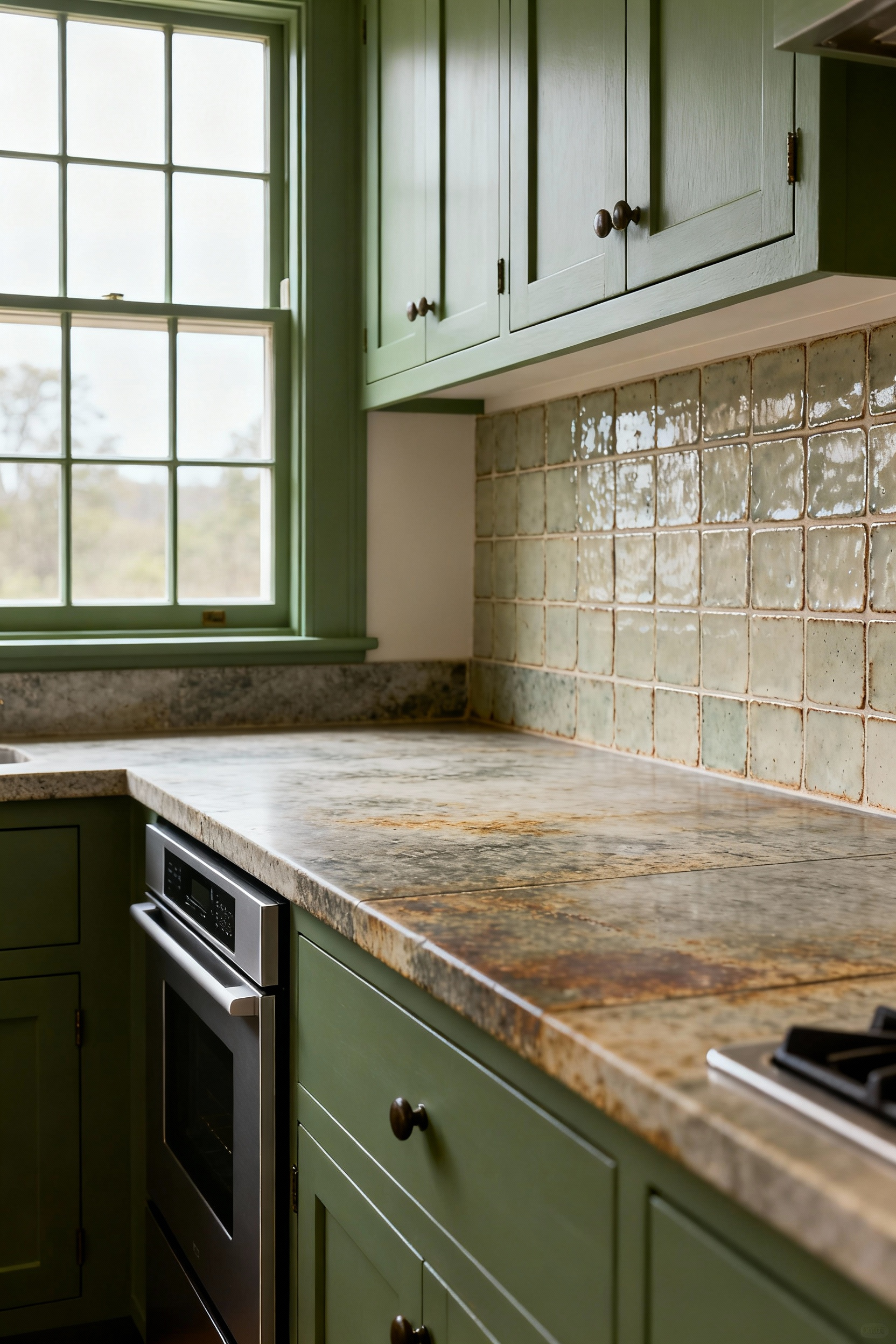
I’ve noticed this often happens with plumbing fixtures and appliances. Simply installing a reproduction Victorian faucet on a modern sink can feel jarring. A better approach is to reinterpret a key historical feature. For example, instead of a cramped, historically inaccurate kitchen, we might study the home’s original butler’s pantry and use its principles of high-quality joinery and hyper-organized storage to inform a new, discreet wall of full-height cabinetry that conceals a modern refrigerator and coffee station.
3. Mastering the Art of Patination
In our modern world, we’re often sold on the idea of flawless, sterile perfection. But enduring beauty embraces imperfection. Mastering the art of patination means selecting materials that are designed to age with grace, acquiring a story through use, touch, and time. Patina is not a flaw; it is a visible narrative of a life well-lived. It imparts a warmth and soul that a factory-perfect finish can never replicate.
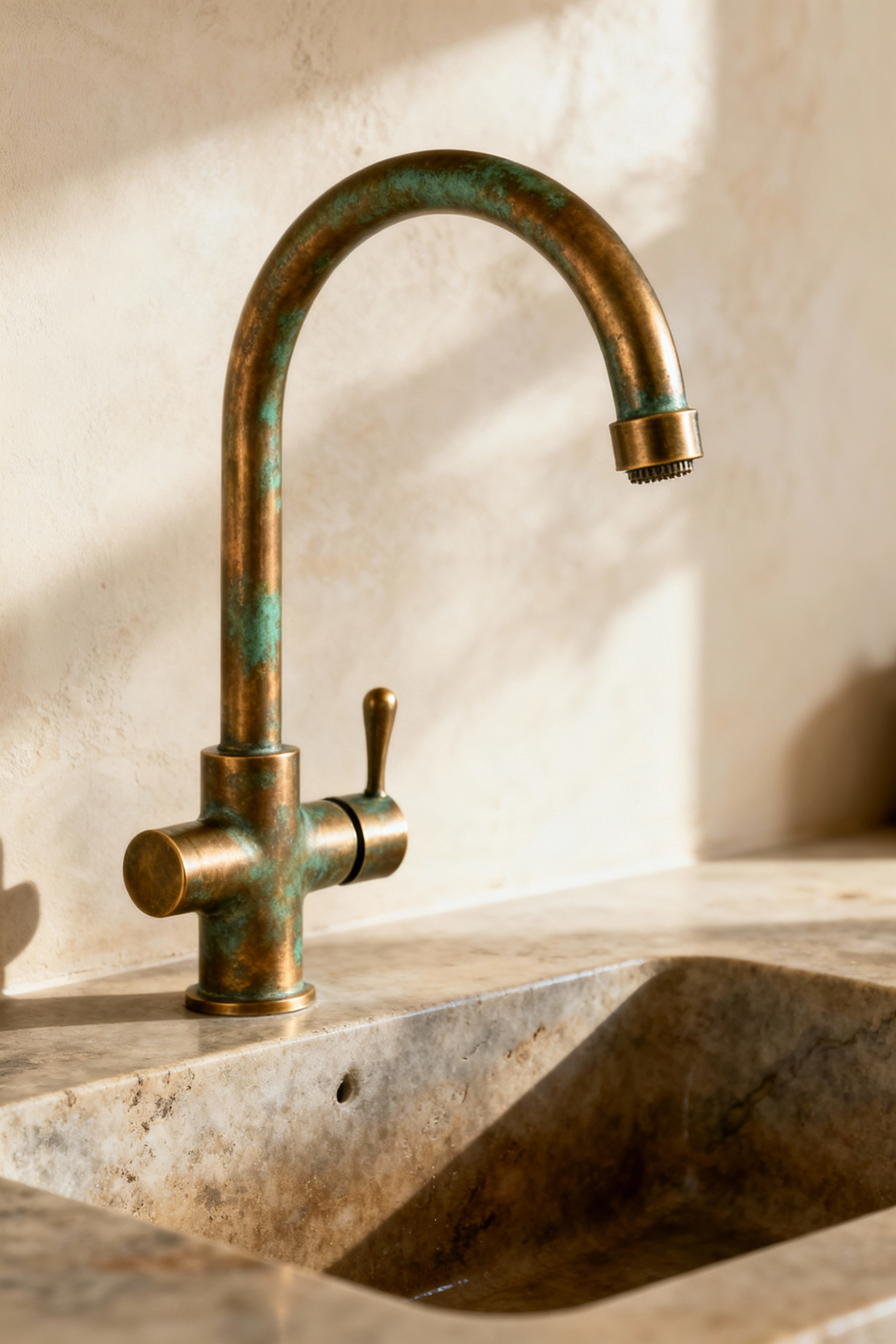
Think of unlacquered brass hardware, which darkens and highlights where hands have touched it for years. Consider a marble countertop that shows the faint etches and marks of countless meals prepared, or a soapstone sink that softens and deepens in color. These materials are chosen not despite their tendency to change, but because of it. Years of professional experience have taught me that encouraging this evolution fosters a less precious, more comfortable relationship with your home, where living isn’t a threat to pristine surfaces.
4. The Imperative of Proportional Harmony
Proportional harmony is the invisible architecture that holds a room together. It’s the art of ensuring that every element—from cabinetry height to island scale to lighting fixture size—relates correctly to each other and to the space as a whole. Without it, even the most exquisite materials will feel discordant. It’s a foundational principle, drawn from classical architecture, that creates a visceral sense of calm and “rightness.”
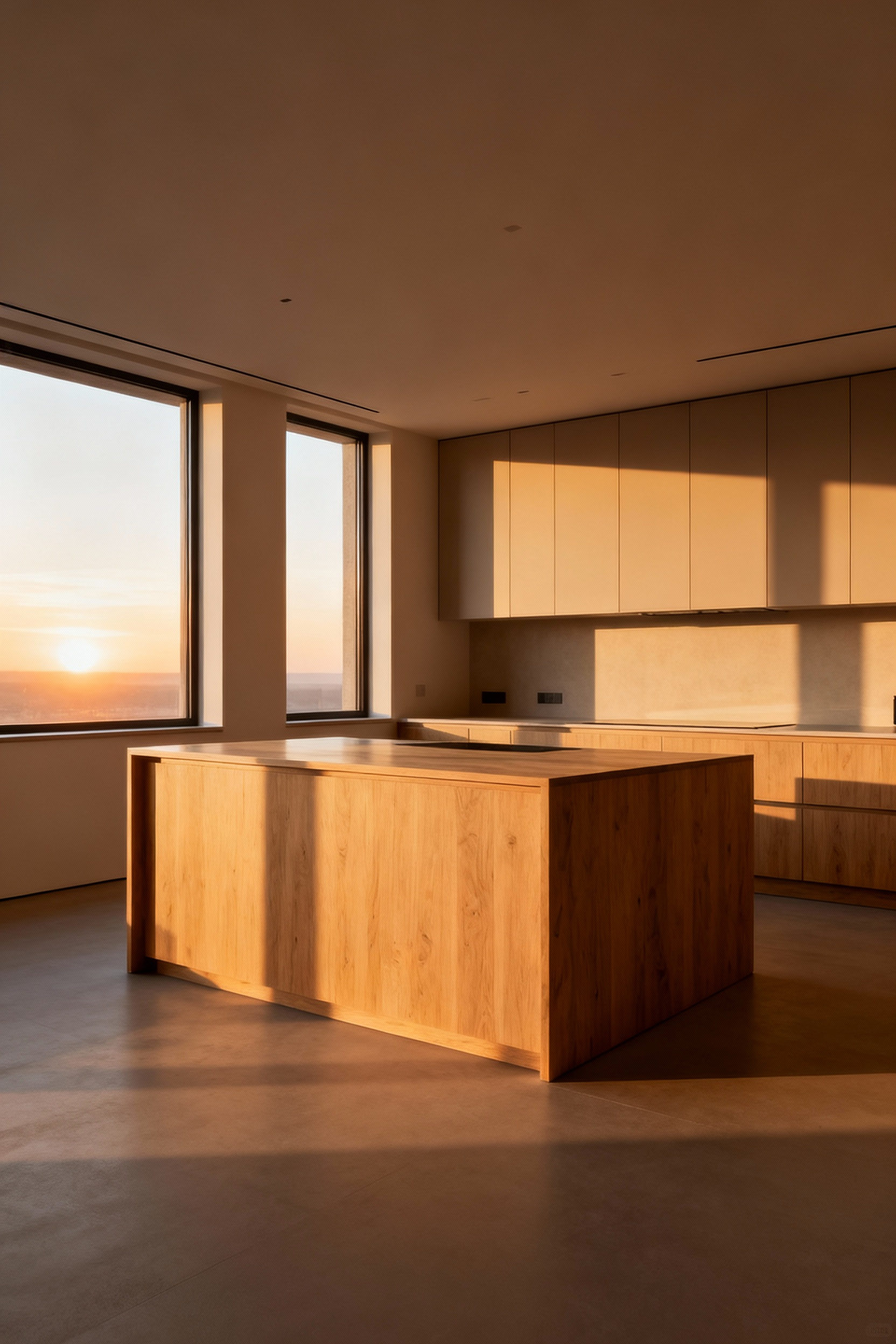
I learned this when renovating a farmhouse kitchen with a magnificent, high-vaulted ceiling. The initial plan called for standard-height cabinetry, which looked comically small and lost in the grand space. We redesigned with taller, more substantial casework that properly addressed the room’s vertical scale, instantly making the room feel balanced and serene. Proportional harmony is about this careful calibration—ensuring no single element overwhelms or underwhelms, allowing the entire composition to achieve a quiet, timeless equilibrium.
Part II: The Integrity of Terroir-Driven Materials
A kitchen’s character is profoundly shaped by its material palette. By choosing materials with a sense of place and an honest nature, we ground the space in authenticity and connect it to the wider world and the long tradition of craftsmanship.
5. Architectural Palimpsests
A palimpsest is an old manuscript where the original writing has been erased but traces remain, with new text written over it. Historic homes are architectural palimpsests. They hold layers of history in their very structure. Engaging with this concept means we don’t just decorate over the past; we reveal it, honor it, and write the next chapter. It’s an archaeological approach that brings unparalleled depth to a kitchen.
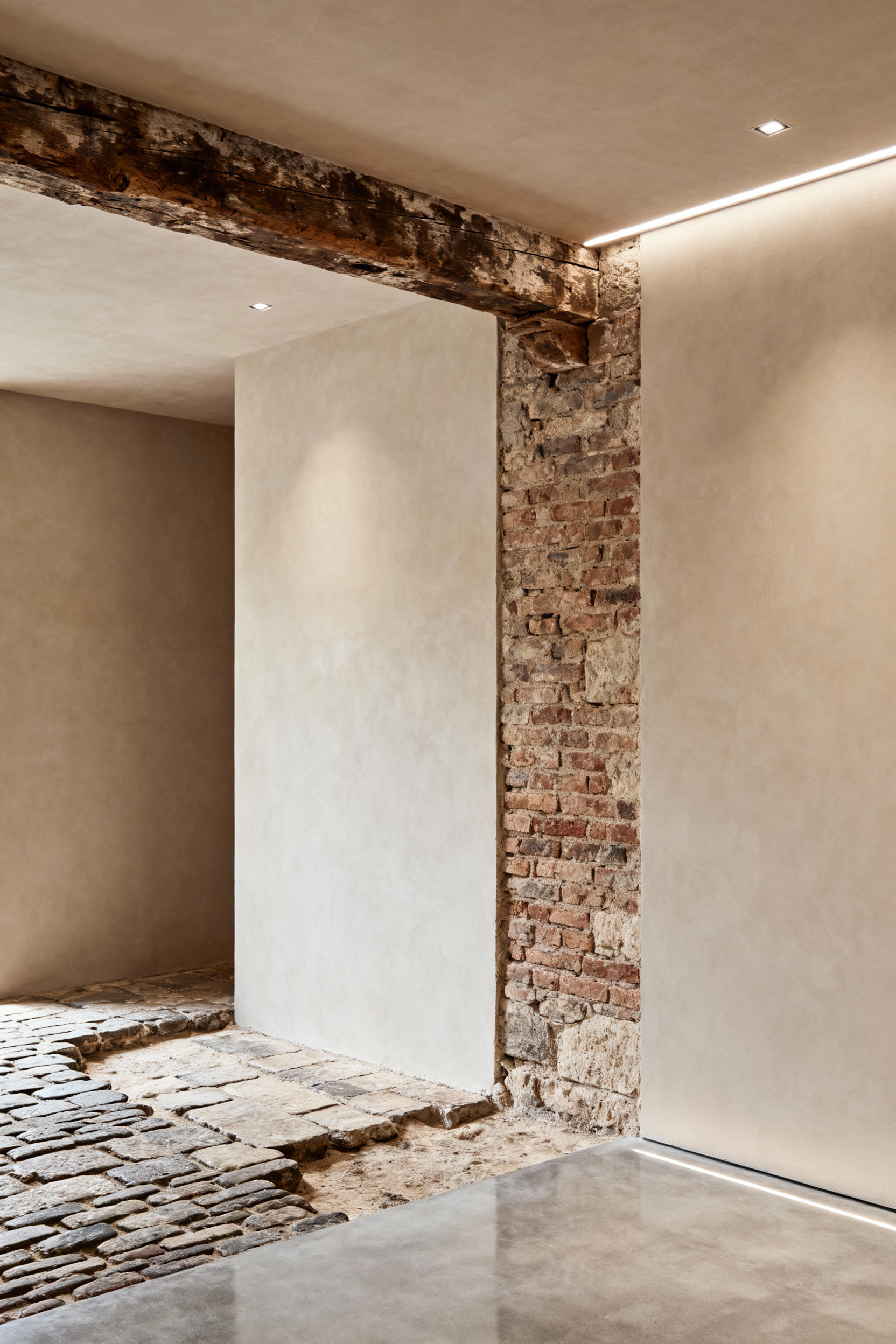
Imagine peeling back plasterboard to discover an original brick chimney breast. Instead of covering it up again, you make it the hero—a textured, authentic backdrop for a modern range. This act of revealing what lies beneath creates a powerful dialogue between old and new. In my own work, I often seek out these opportunities to let the house tell its story, creating a kitchen that feels not just designed, but curated from its own history.
6. Reverencing Indigenous Stone Varietals
Why import stone from halfway around the world when the geology of your own region has a unique story to tell? Using indigenous stone—like Vermont slate in a New England farmhouse or Texas limestone in a Hill Country ranch—anchors a home to its specific place on earth. These materials have a “terroir,” a sense of place that connects your kitchen directly to the landscape outside your window.
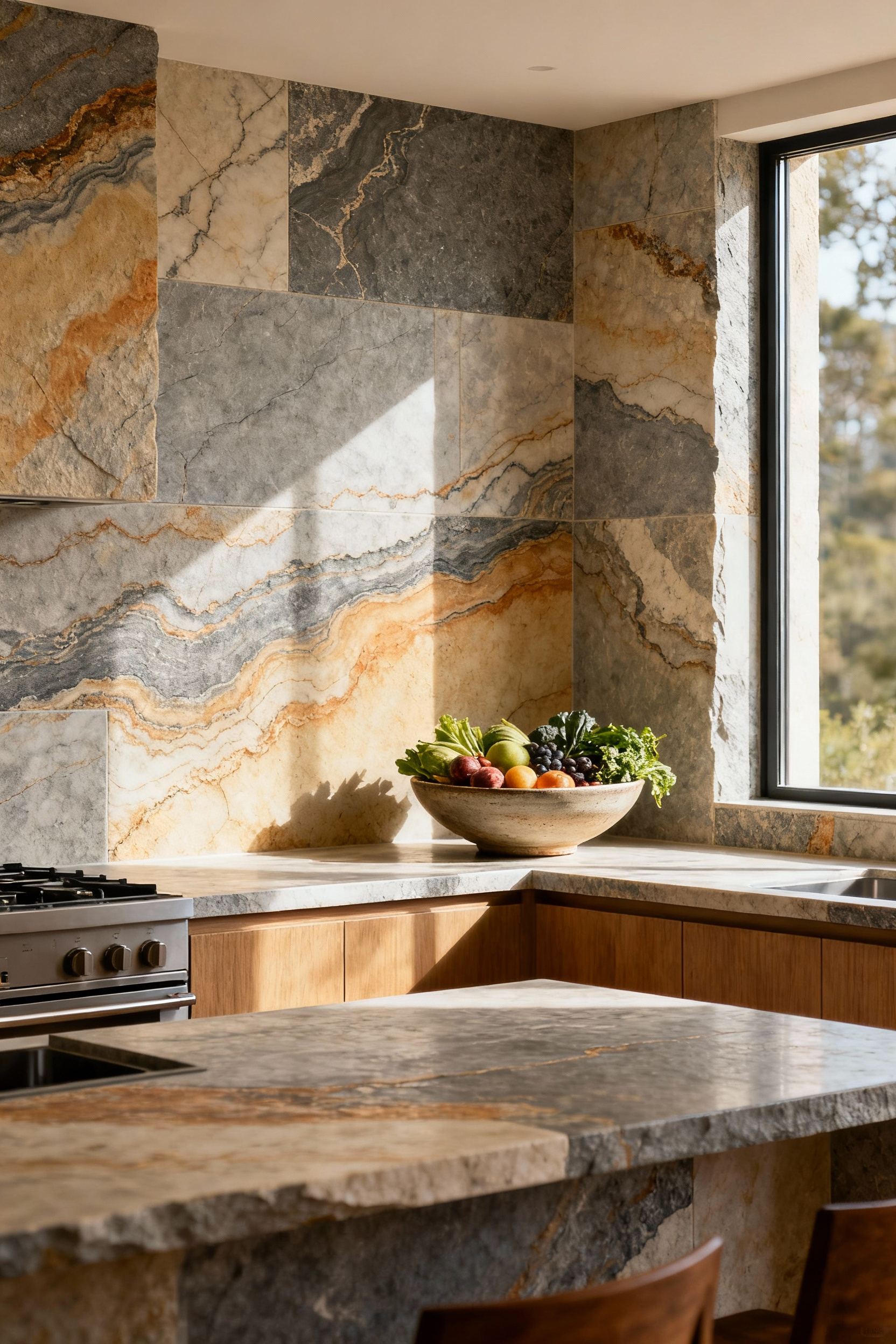
Each local stone possesses a unique color palette, vein structure, and mineral composition forged by millions of years of geological history. Choosing to celebrate it transforms a simple countertop into a piece of a larger narrative. It’s a commitment to authenticity that lends a quiet gravitas to the room and ensures your kitchen feels completely at home in its environment.
7. The Luminescence of Hand-Forged Metals
There is a quality to an object shaped by a human hand that a machine can never replicate. Integrating hand-forged metals—iron, bronze, copper—introduces an artisanal soul into the kitchen. The subtle hammer marks on an iron pot rack or the unique texture of a cast bronze cabinet pull tells a story of craft and intention.
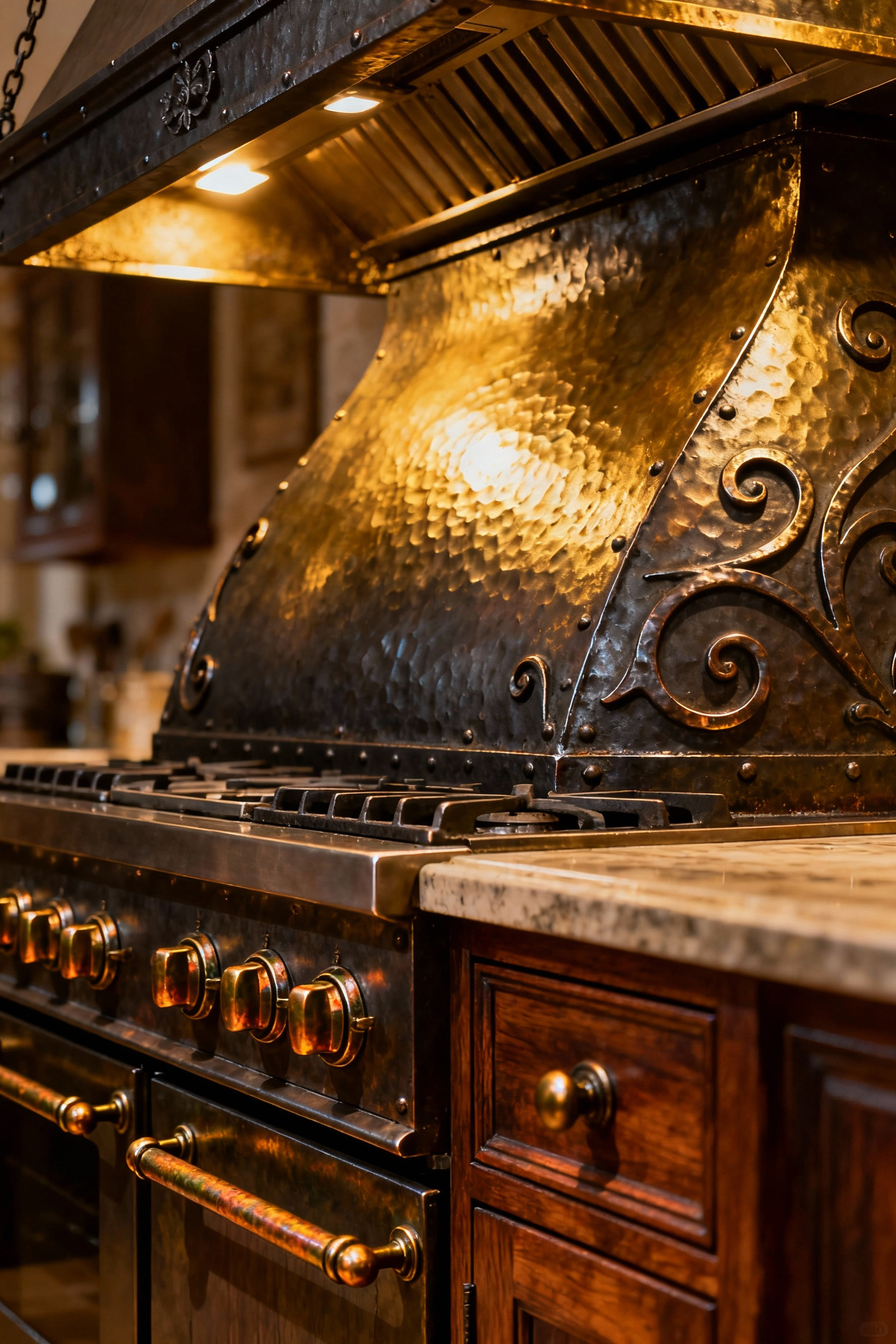
These metals possess a living quality. A custom copper range hood is not a static object; it evolves, its patina shifting with time and exposure to the kitchen’s atmosphere. I’ve found that these artisanal elements often become the details that clients cherish most. They offer a tactile connection to the maker and elevate the kitchen from a collection of products to a curation of crafted objects.
8. Curating Fine Cabinetry with Enduring Joinery
Your kitchen cabinetry should be furniture. It is the primary architectural element you add to the space, and it demands an investment in quality construction. This means rejecting the world of disposable particle board boxes and embracing the time-honored techniques of enduring joinery—dovetail joints, mortise and tenons, and solid wood construction.
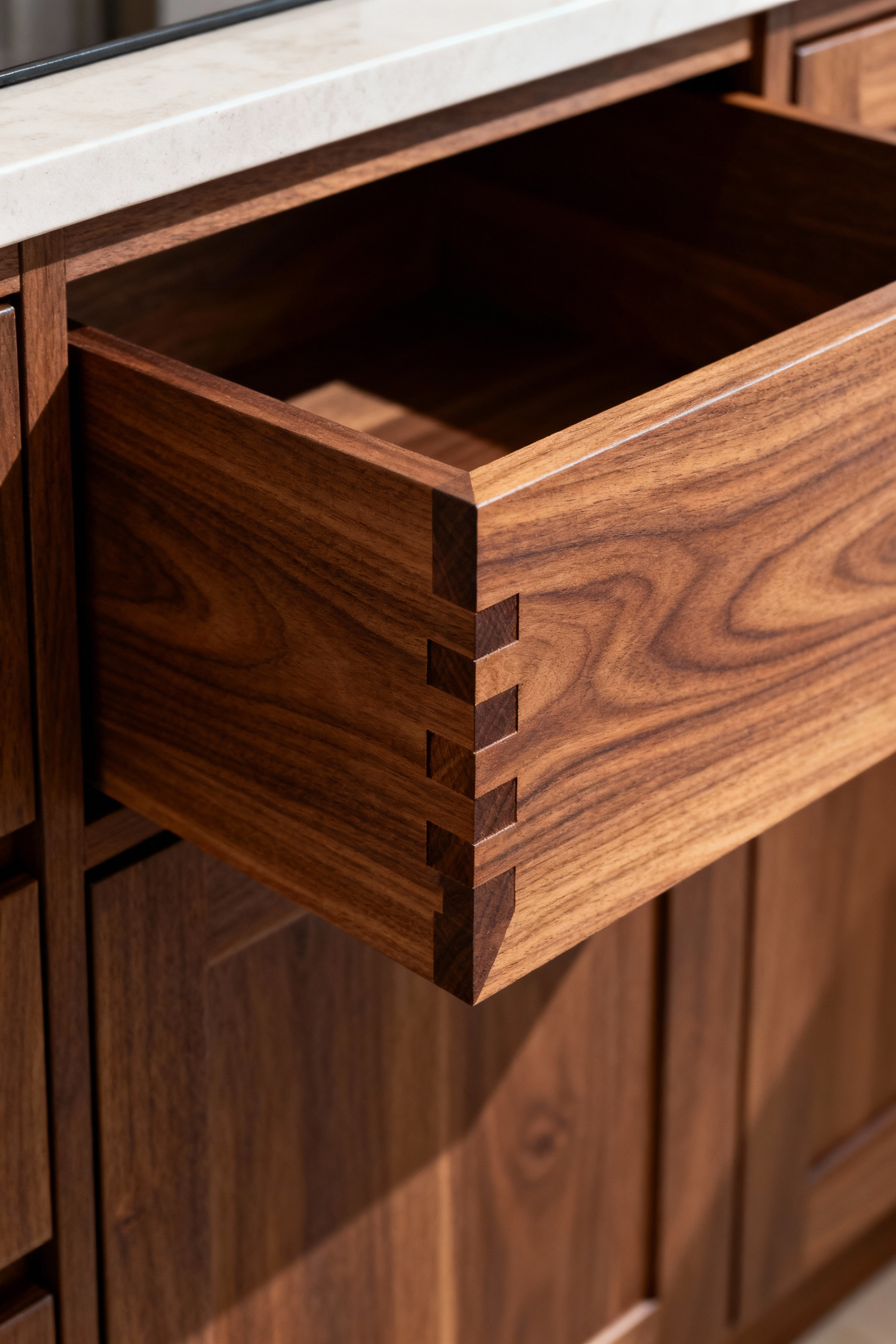
You can feel the difference. The satisfying weight of a solid wood door, the silent precision of a well-made dovetailed drawer—these things speak to a level of quality that will endure for generations. From my work in period-appropriate renovation, I can tell you that well-built cabinetry not only performs better for longer but also forms the unshakeable foundation of the room’s aesthetic integrity. It is the very backbone of enduring kitchen design decor.
9. Earthenware and Terracotta
To infuse a kitchen with immediate warmth and a deep sense of history, few materials can rival the humble beauty of earthenware and terracotta. Fired from the earth itself, these materials speak a universal language of craft and tradition. Whether as flooring or a backsplash, they bring a textural richness and organic character that instantly counteracts the coldness of modern appliances.
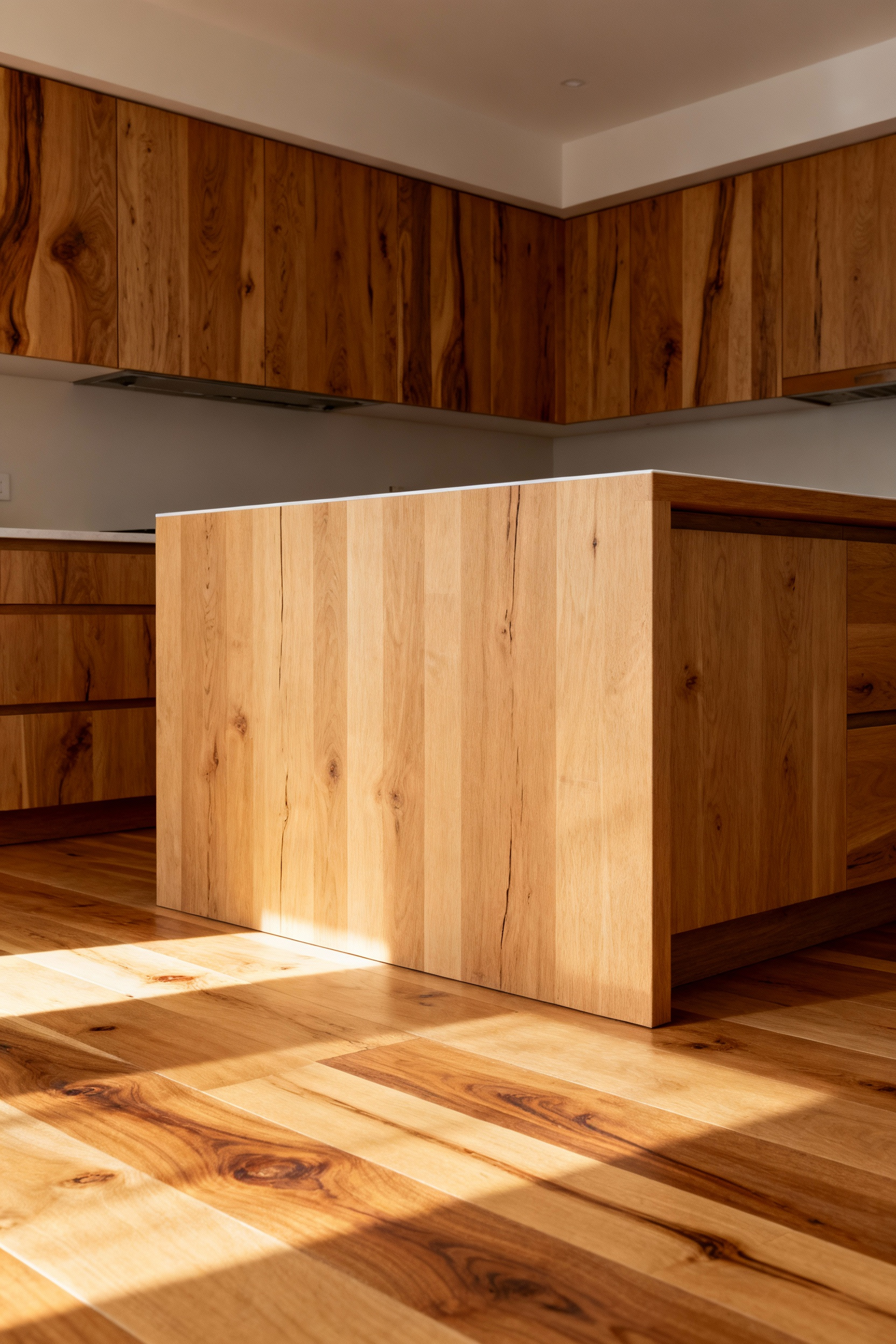
Reclaimed terracotta tiles are especially powerful. Each tile carries a history—the subtle wear from centuries of footsteps, the variations in color from its time in the sun. Using these on a kitchen floor provides an instant sense of permanence and grounding. It feels as though the floor has been there forever, offering a warm, forgiving foundation that only grows more beautiful with time.
Part III: The Choreography of Modern Functionality
An enduring kitchen must work as beautifully as it looks. This requires a sophisticated choreography of space, light, and modern systems, engineered to make daily life more efficient, comfortable, and intuitive.
10. Redefining the Kitchen Work Triangle
The classic work triangle—a rigid path between sink, refrigerator, and stove—was designed for a single cook in a closed-off room. It’s largely obsolete. Today’s kitchen is a multi-functional, multi-person hub, and it demands a more fluid concept of “work zones.” This modern approach focuses on creating distinct areas for specific tasks—prep, cooking, cleanup, baking, socializing—that can function independently without causing traffic jams.
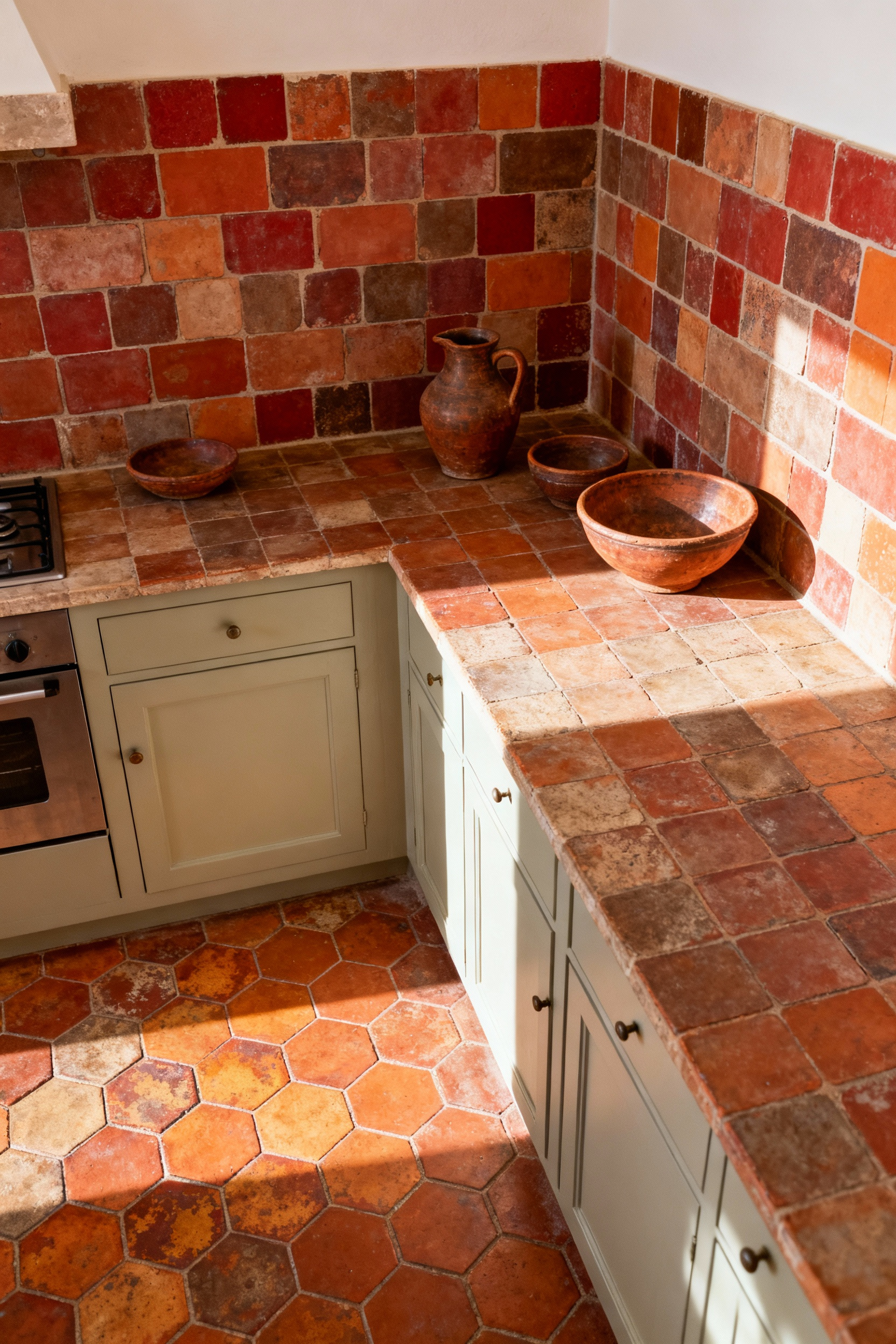
This redefinition might mean placing a small prep sink on the island, creating a dedicated beverage station with its own refrigeration, or grouping all baking supplies and equipment in one dedicated cabinet. What I tell my clients is that we’re designing an ergonomic dance floor, not a rigid factory line. The goal is an intuitive flow that makes using the kitchen—whether alone or with a crowd—feel effortless.
11. Sculpting Natural Illumination Pathways
Natural light is a building material. You can and should sculpt with it. A kitchen’s design should be fundamentally shaped by its access to daylight, maximizing its entry and thoughtfully managing its effects throughout the day. This goes far beyond just putting a window over the sink. It’s about strategic fenestration—perhaps adding transom windows to bring in high light, or enlarging an opening to frame a garden view.
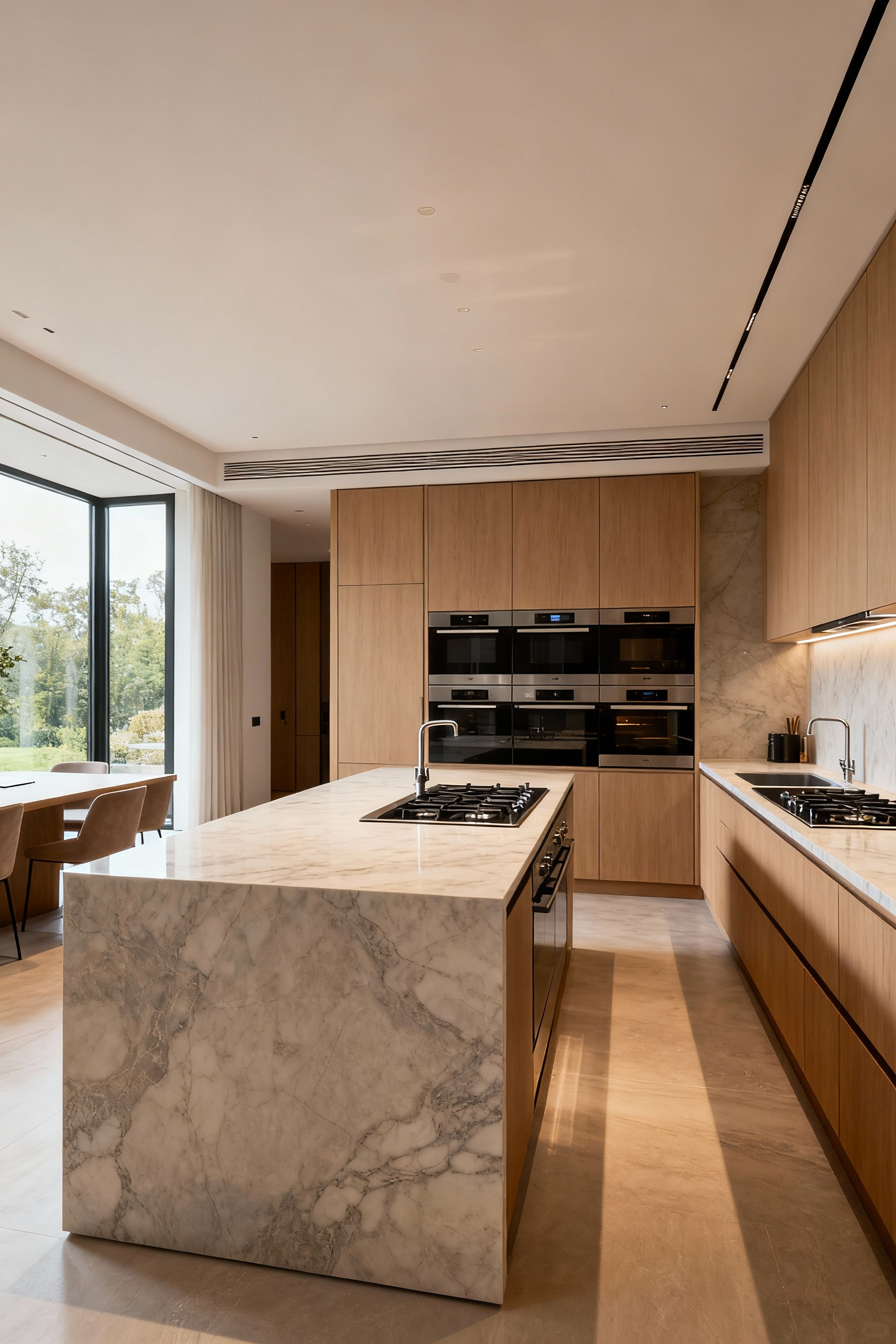
The reflectivity of your chosen surfaces also plays a crucial role. A honed marble countertop will diffuse light softly, while a polished backsplash might bounce it more dramatically. Years of professional experience taught me that a well-lit kitchen isn’t just about brightness; it’s about creating a connection to the outdoors and the passage of time, which profoundly enhances our sense of well-being within the space.
12. Orchestrating Artificial Luminescence through Layered Schemes
When the sun goes down, a sophisticated lighting plan takes over. A single, glaring overhead fixture is a cardinal sin in kitchen design. The right approach is to layer your lighting, with each layer serving a specific purpose: ambient, task, and accent. Ambient lighting (like recessed cans or a central fixture) provides overall illumination. Task lighting (under-cabinet strips, pendants over an island) focuses bright, shadow-free light exactly where you need it for work.
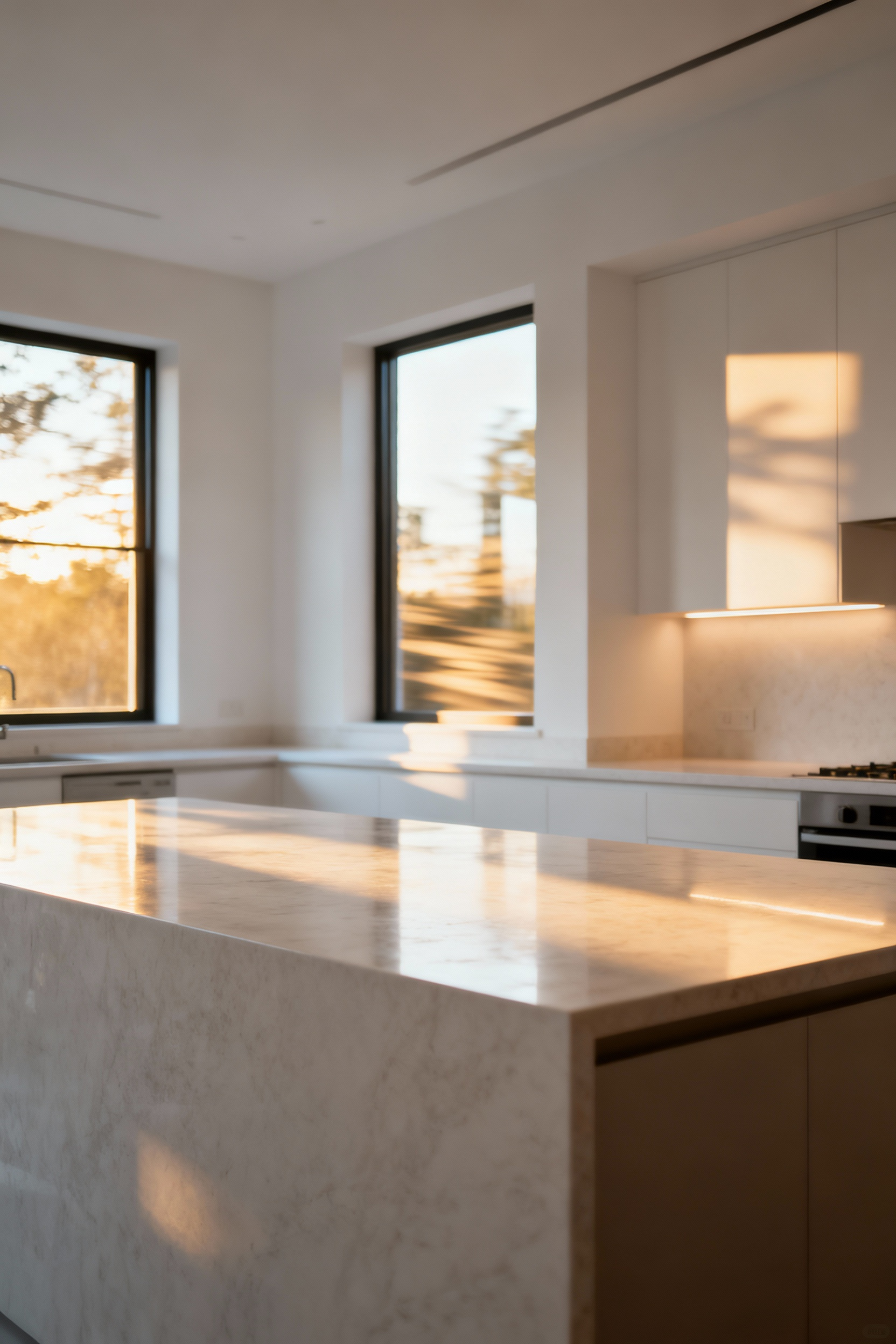
Accent lighting is the final, transformative layer. This could be small spotlights highlighting a piece of art, or soft lighting inside a glass-fronted cabinet. Each layer should be on its own dimmer switch, giving you complete control over the mood. You can transition from a bright, functional workspace to a soft, intimate glow for dinner with the touch of a few buttons.
13. Structuring Inherent Flexibility with Convertible Prep Zones
A truly intelligent kitchen is designed for adaptability. It anticipates changing needs by building in flexibility from the start. This can manifest in convertible prep zones—spaces and surfaces that can serve multiple functions. Think of an island with a recessed section that holds a removable butcher block, revealing a stainless steel basin for icing drinks when you’re entertaining.
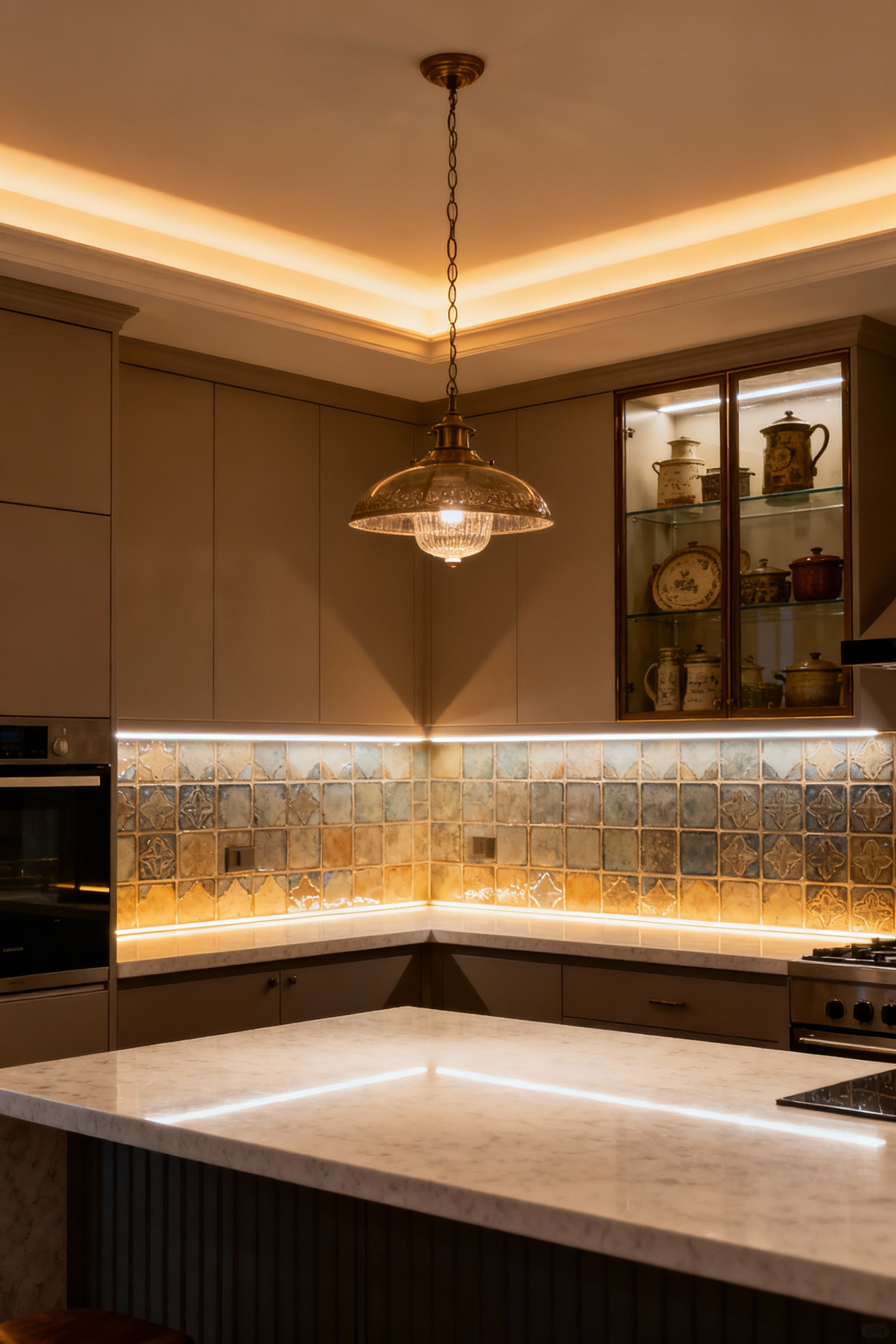
This could also be a section of countertop that lifts to reveal a hidden charging station and small appliance storage, or an island that can extend to accommodate more diners. Designing for this kind of inherent flexibility ensures the kitchen can evolve with your life. It moves beyond a static design to become a responsive, dynamic partner in your home.
14. The Integration of Artisanal Ventilation Systems
Ventilation is non-negotiable, but a utilitarian stainless steel hood doesn’t have to be the only option. An extractor hood can, and should, be a significant design element. Treat it as a piece of sculpture or an architectural feature. It can be clad in the same wood as your cabinetry, plastered to blend seamlessly with the walls, or crafted from hammered copper or blackened steel as a stunning focal point.
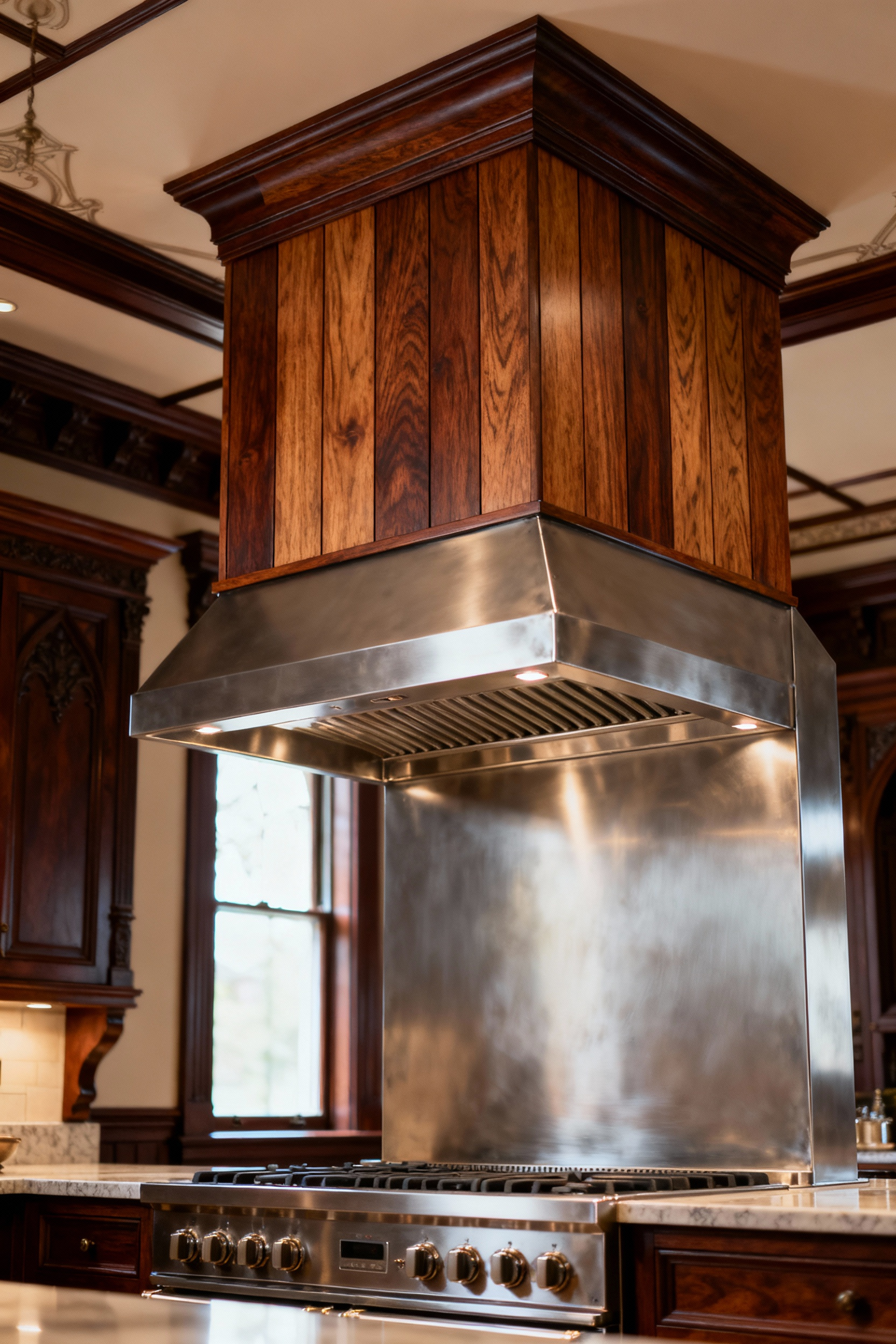
In my restoration work, creating a custom ventilation shroud is often key to integrating a high-performance system into a historic space. It allows us to achieve state-of-the-art air quality control without introducing a jarringly modern element. This way, essential functionality doesn’t just coexist with the design—it actively enhances it.
Part IV: Integrating Modern Needs with Timeless Ethos
The final challenge is to seamlessly integrate the demands of 21st-century life—our technology, our storage needs, our open-plan living—without compromising the timeless character we’ve so carefully cultivated.
15. The Discerning Concealment of Technocratic Elements
Modern life is filled with technology, but a kitchen’s atmosphere shouldn’t be dominated by beeping screens and glowing lights. The most refined kitchens practice the art of technocratic concealment. This means integrating appliances behind custom panels that match the surrounding cabinetry, allowing refrigerators and dishwashers to disappear completely.
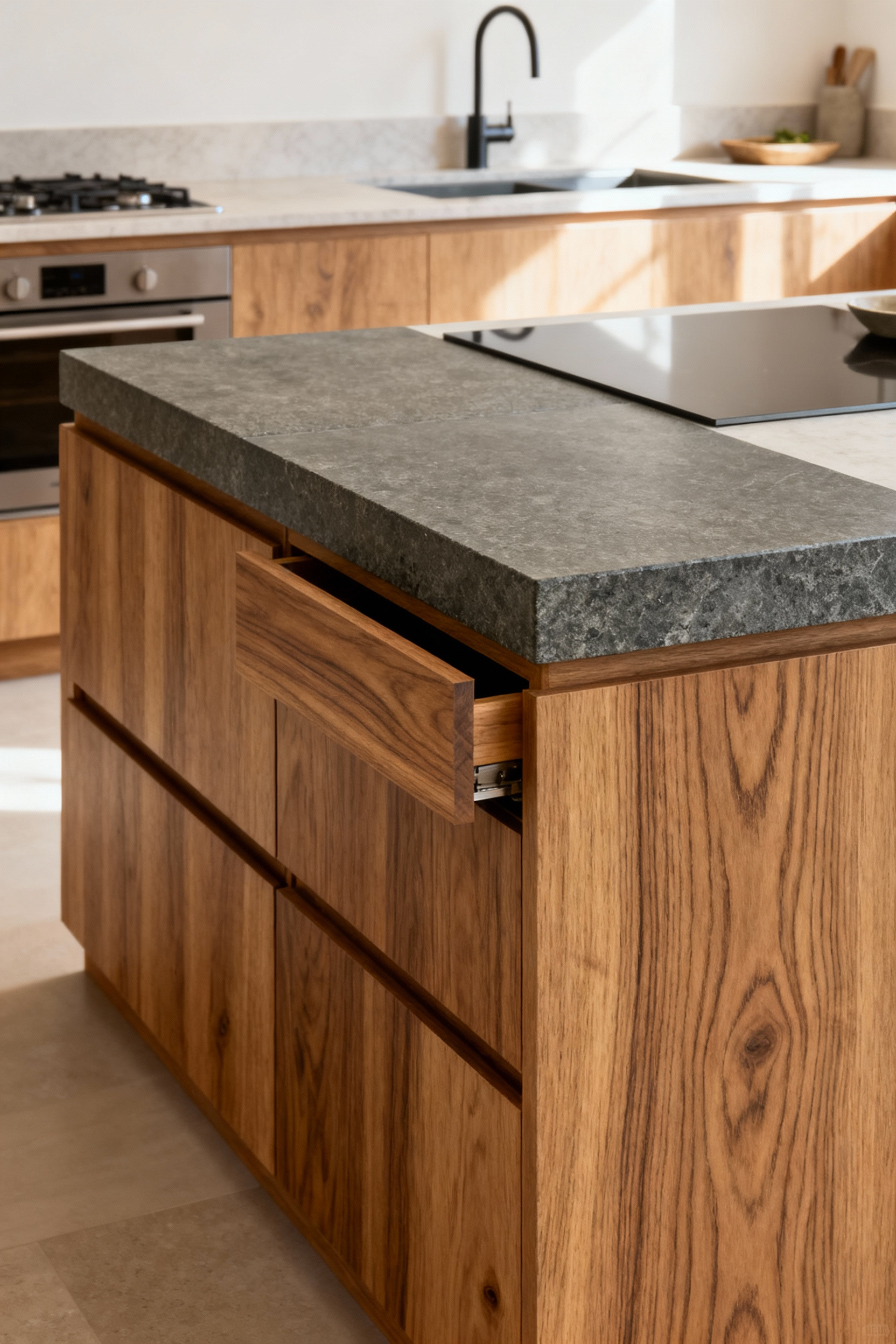
Beyond major appliances, this ethos applies to the small things. “Appliance garages” keep toasters and blenders off the counter but easily accessible. Drawers can be fitted with integrated charging stations to hide the clutter of devices. The goal is to make technology a discreet servant, always available but never visually intrusive, preserving the serene and timeless quality of the space.
16. Curating Intelligent Storage Modalities for Bespoke Utility
Great kitchen design isn’t just about what you see; it’s about what you don’t. Intelligent storage is the invisible engine that makes a kitchen function effortlessly. This goes far beyond standard shelves and drawers. It’s about bespoke utility: full-height pantry cabinets with pull-out drawers, custom dividers for pots and cutlery, and clever corner solutions that make every inch of space accessible.
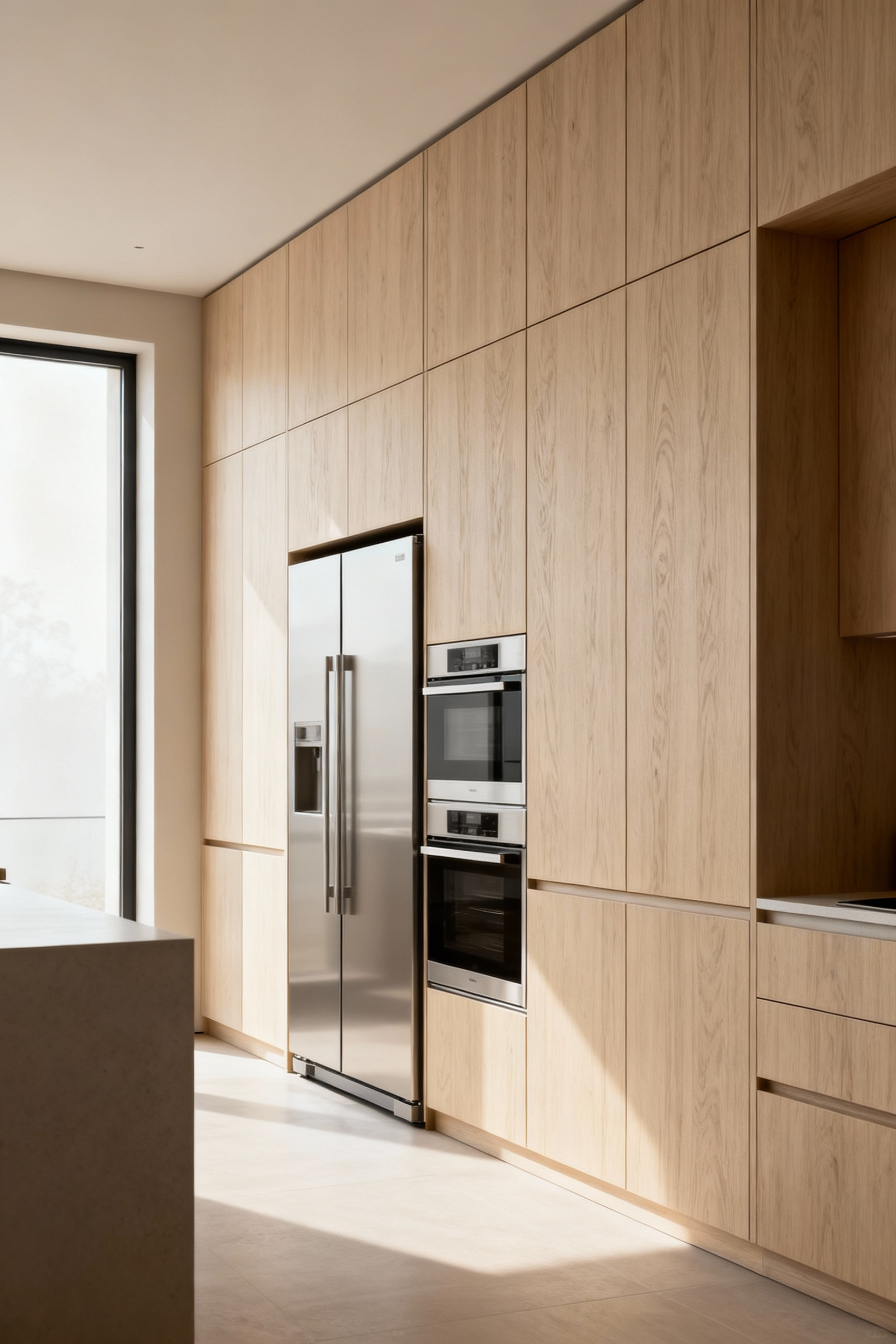
In my historic home renovation specialist practice, I often find that older homes lack sufficient storage. My solution isn’t just to add more cabinets, but to design smarter ones. We analyze a client’s specific inventory—from their bakeware collection to their spices—and design a home for everything. This removes daily friction and creates a profound sense of order and calm.
17. Cultivating a Seamless Transition from Culinary to Conversational Spaces
The kitchen is no longer an isolated workspace; it’s the center of social life in the home. The design must therefore cultivate a seamless transition into adjoining living and dining areas. This is achieved by creating a cohesive visual language through consistent materials, color palettes, and architectural details.
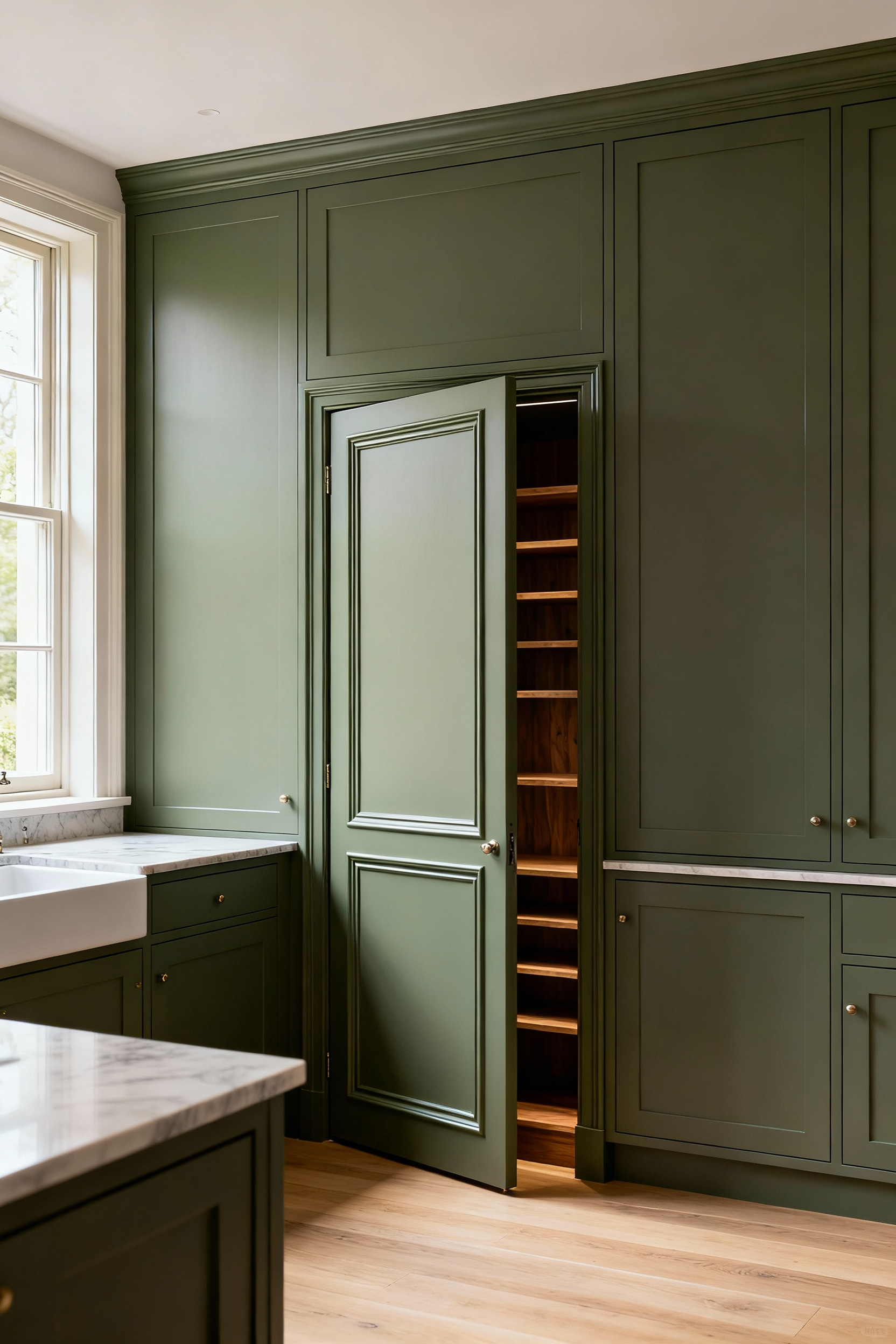
Using the same flooring throughout the open space is the most effective way to unify it. An island with seating acts as a natural bridge between the “work” zone and the “social” zone. By keeping sightlines open and reducing visual clutter, you create an environment that encourages interaction, allowing the cook to be part of the conversation and making entertaining feel natural and inclusive.
18. The Resilience and Adaptability of Legacy Surfaces
Choose surfaces that tell a story and are not afraid of life. Legacy surfaces are materials like soapstone, solid wood, marble, slate, and high-quality handmade tile that are chosen for their resilience and ability to age beautifully. They don’t degrade with use; they develop a character-rich patina that enhances their beauty over time.
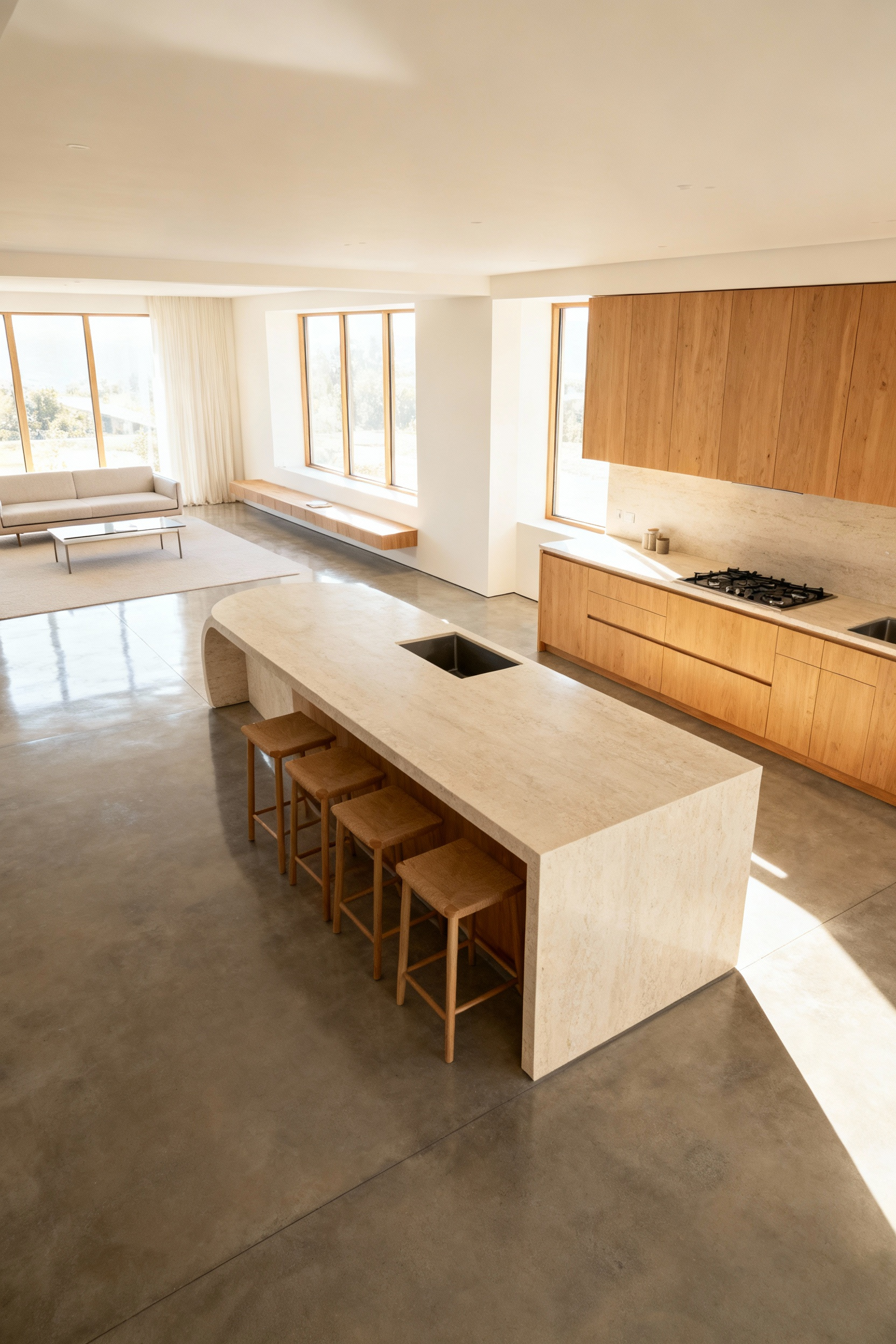
This is a conscious rejection of materials designed for obsolescence, like laminates or plastics that chip and peel. Legacy surfaces represent an investment in permanence. They require a mindset shift—to embrace an occasional etch on marble or a deepened tone in wood not as a flaw, but as a mark of a kitchen that is truly lived in and loved.
19. Prioritizing the Haptic Experience
Beyond the visual, a truly exceptional kitchen engages the sense of touch. The haptic experience—the feeling of materials under your hand—is a crucial, if often overlooked, element of design. It’s the substantial, cool smoothness of a thick stone countertop, the satisfying weight and click of a solid brass cabinet latch, and the warm, organic grain of a wooden drawer pull.
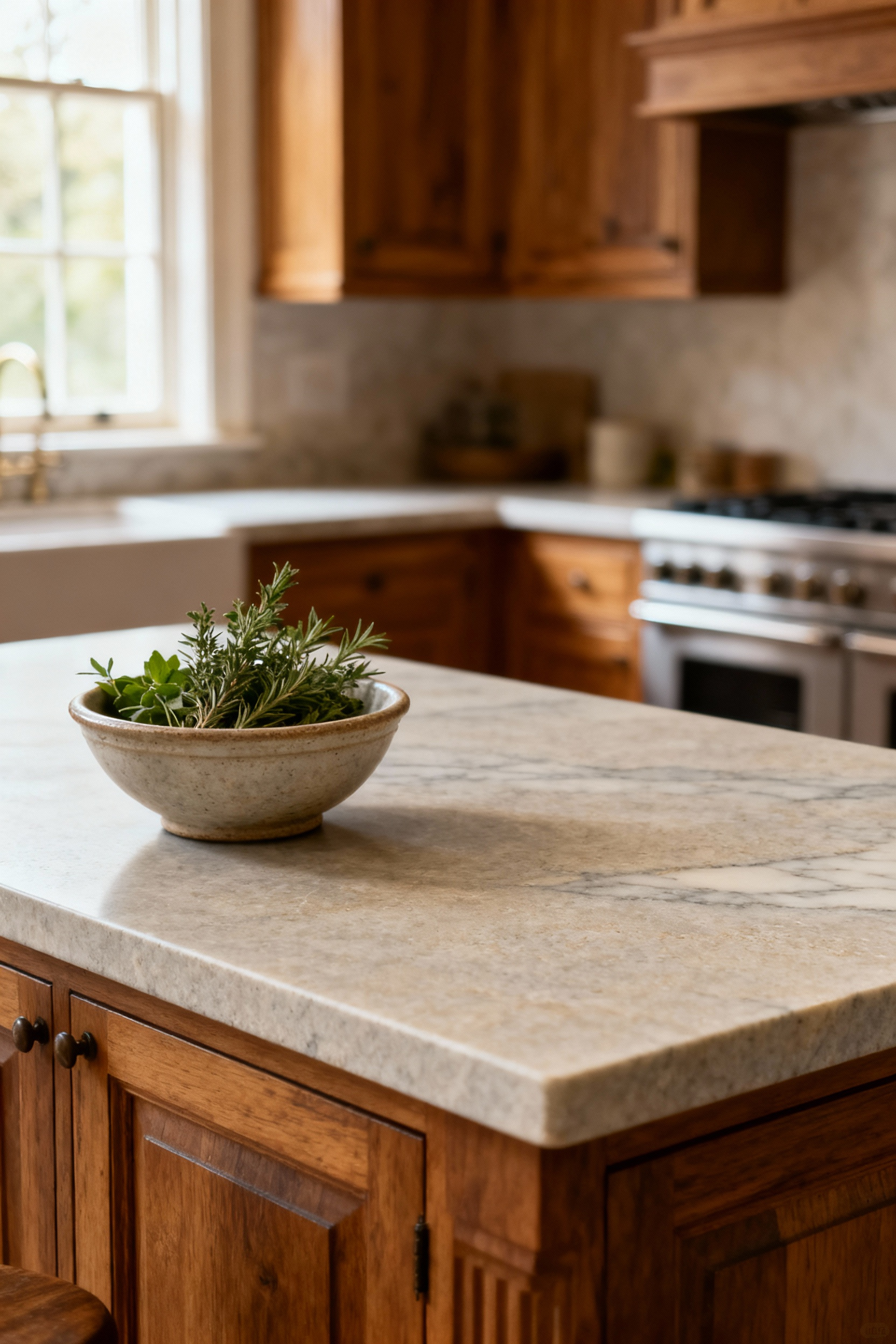
This focus on tactility guides you toward materials with integrity. A hollow, lightweight drawer front feels fundamentally different from a solid wood one. Choosing objects and surfaces that are pleasing to the touch adds a subliminal layer of quality and comfort to the room. I’ve noticed that when these details are right, people are subconsciously drawn to interact with the space more, reinforcing the kitchen’s role as a comforting and engaging heart of the home.
20. Futurism Through Fidelity: Strategizing for Architectural Longevity and Design Agnosticism
The ultimate goal is to create a kitchen that will outlive any trend. I call this “futurism through fidelity”—a strategy that is faithful to the principles of good design, ensuring architectural longevity. This means creating a kitchen with such strong “bones” that it can adapt to future stylistic changes without needing a full renovation. It is intentionally ‘design agnostic.’
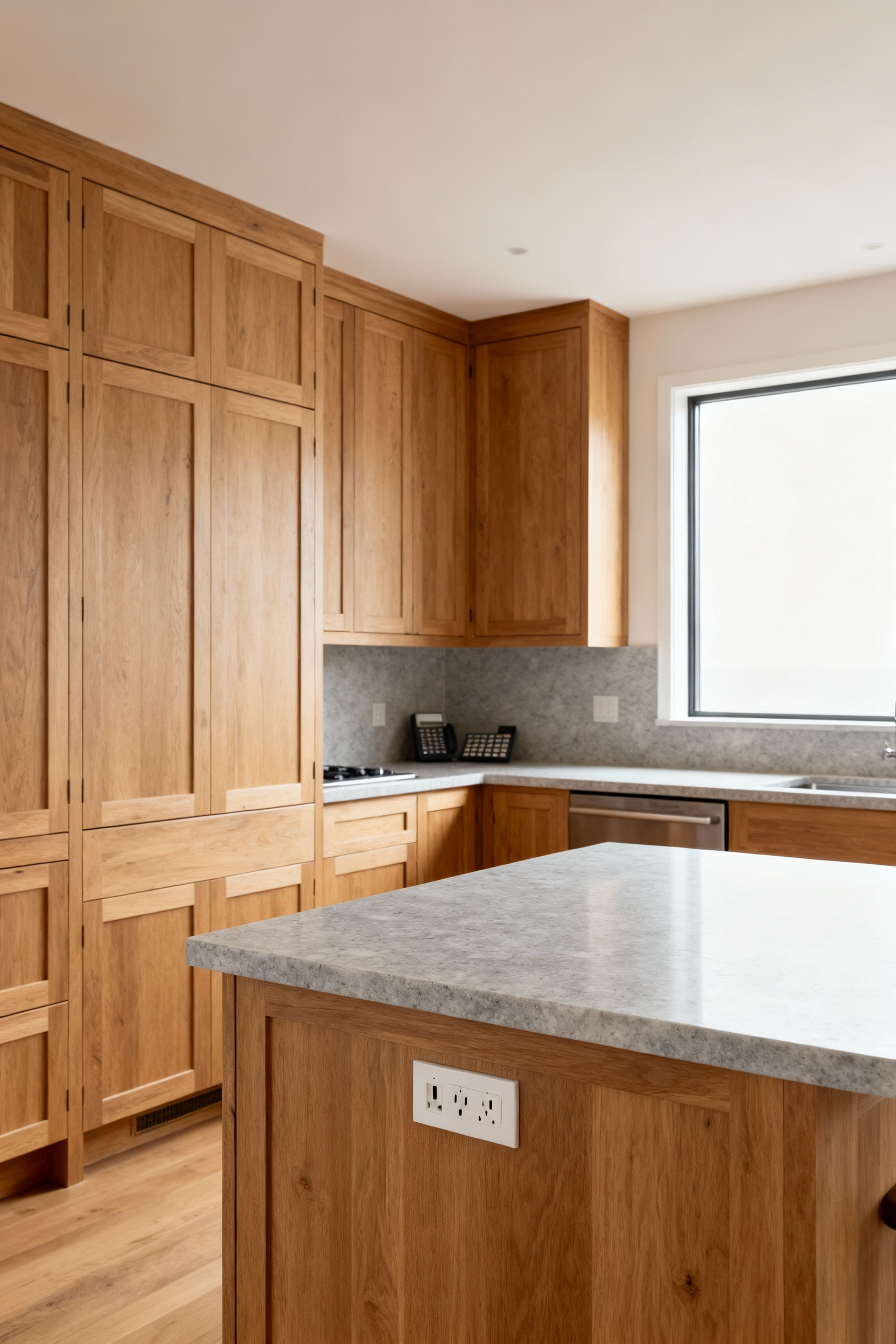
This is achieved by investing in the foundational elements: a timeless layout, high-quality construction, and a neutral, authentic material palette. A kitchen with a simple, elegant foundation of white oak cabinetry, durable stone counters, and good natural light will look just as relevant in 30 years as it does today. It becomes a versatile, enduring canvas upon which future generations can add their own layers of personality. This is the very definition of a sustainable, legacy-focused design.
Conclusion
Throughout these twenty principles, a single truth emerges: a kitchen with enduring character is an intentional kitchen. It is a space born not from chasing trends, but from a thoughtful dialogue between a home’s history, the integrity of honest materials, and the rhythms of modern life. As we’ve explored, every decision—from honoring architectural provenance to specifying enduring joinery—contributes to a whole that is far greater than the sum of its parts.
To undertake such a project is to become a steward of your home’s narrative. By applying these insights to your own kitchen design decor, you move beyond mere renovation and into the realm of restoration and thoughtful evolution. You create a space that feels both timeless and deeply personal, a functional sanctuary that supports and enriches daily life. The result is more than just a beautiful room; it is a legacy—a warm, beating heart for your home that will welcome and nurture for generations to come.
